外研社必修五module4 carnival全单元教案
- 格式:doc
- 大小:425.00 KB
- 文档页数:16
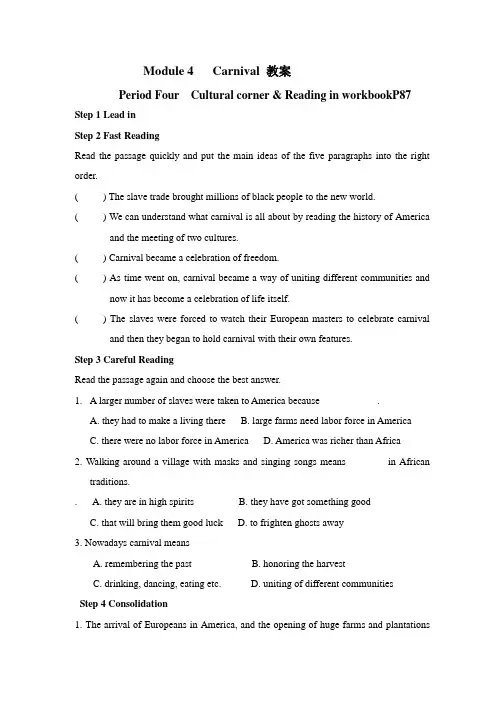
Module 4 Carnival 教案Period Four Cultural corner & Reading in workbookP87 Step 1 Lead inStep 2 Fast ReadingRead the passage quickly and put the main ideas of the five paragraphs into the right order.( ) The slave trade brought millions of black people to the new world.( ) We can understand what carnival is all about by reading the history of America and the meeting of two cultures.( ) Carnival became a celebration of freedom.( ) As time went on, carnival became a way of uniting different communities and now it has become a celebration of life itself.( ) The slaves were forced to watch their European masters to celebrate carnival and then they began to hold carnival with their own features.Step 3 Careful ReadingRead the passage again and choose the best answer.1. A larger number of slaves were taken to America because ___________.A. they had to make a living thereB. large farms need labor force in AmericaC. there were no labor force in AmericaD. America was richer than Africa2. Walking around a village with masks and singing songs means _______ in Africantraditions.. A. they are in high spirits B. they have got something goodC. that will bring them good luckD. to frighten ghosts away3. Nowadays carnival means______________A. remembering the pastB. honoring the harvestC. drinking, dancing, eating etc.D. uniting of different communitiesStep 4 Consolidation1. The arrival of Europeans in America, and the opening of huge farms and plantationsto grow cotton, fruit and vegetables, meant________________________(急需)for people to work on them.lions of people ________________(被强行带走)from their homes in Africa and ________(运送) to the New World to________________(当奴隶) .3.When the slave trade _____________(被废除)in 1838 the former slaves ____________(沿袭了)the carnival.4.They painted their faces white, _________(模仿)their masters and ________ _______ ______(取笑) them.5._________________________(随着时间的流逝), the white inhabitants of the islands began to ________ _________ ________(加入) the carnival, too.Step 4 Post-readingRead the passage “Christmas Traditions” in the workbook on page 87 and finish doing activities 7&8.Step 5 Discussion: Describing a Chinese festival (eg: the Spring Festival)Work in groups. Choose a Chinese festival. Discuss with things and write notes:●where and when it is celebrated●what happens during the festival●costumes and foodStep 5 HomeworkWrite a description of the festival for visitors to China.。
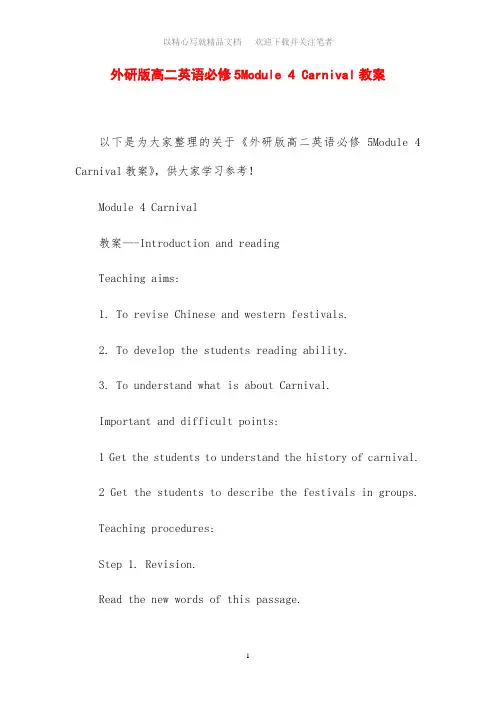
外研版高二英语必修5Module 4 Carnival教案以下是为大家整理的关于《外研版高二英语必修5Module 4 Carnival教案》,供大家学习参考!Module 4 Carnival教案---Introduction and readingTeaching aims:1. To revise Chinese and western festivals.2. To develop the students reading ability.3. To understand what is about Carnival.Important and difficult points:1 Get the students to understand the history of carnival.2 Get the students to describe the festivals in groups.Teaching procedures:Step 1. Revision.Read the new words of this passage.Step 2. Introduction1. We have learned many festivals both Chinese and the Western. What festivals do you know?Divide the class into 2 groups. One group is for Chinese Festivals, the other group is for Western festivals.Make a list of them on the blackboard..2. Turn to Page 31—Match the festivals with the description.Step 3. Lead-inToday we will learn another festival ---- Carnival. It originates from Europe, and during thesedays, people often love wearing special clothes and masks for it.Step 4. Fast-readingMatch the main idea with every paragraph.Paragraph 1 A meaning of carnival and how it was celebrated Paragraph 2 B the law about wearing masksParagraph 3 C general impression of carnivalParagraph 4 D how it is celebrate today in Venice and the feature of itParagraph 5 E carnival in Venice and the problem it caused Paragraph 6 F the revival of the tradition of celebrating it.(Answers: 1—6 CAEBFD)Step 5. Further-readingRead the passage and answer the questions.1. Where does Carnival come from? What does it mean?2. When was it celebrated?3. Where was the most famous Carnival in Europe?4. How long did the first Carnival in Venice last? What about now?5. Did the government of Venice encourage the wearing of masks?6. Who started the Carnival again, tourists or students?(Answers: 1. “Carnival” comes from two Latin words, meaning “no more meat”. 2. It beganjust after Christmas. 3. The most famous carnival in Europe was in Venice. 4. At thebeginning, it lasted for just one day. 5. No. 6. The students started the Carnival. )Step 6. VocabularyActivity 1: Read through the words in the box and have the students repeat them individually.Ask the students to complete the task individually, then check with a partner.Check the answers together:(Answers: 1. confusion 2. excitement 3. mask 4. mystery 5. magic 6. costume 7. crowd8. tradition 9. atmosphere)Activity 2: Choose the correct meanings of the words and phrases.Check the answers one by one.(Answers: 1—4 babb 5—8 abbb)Step 7. DiscussionDiscuss in groups of four.1. What is the feature of carnival in Venice?2. Which is your favourite festival?Step 8. Homework1. Workbook—on Page 87.Read the passage and match the headings with the text.2. Write a short passage about your favorite festival.--------------------文章说明---------------------本文是经过精选整理后的精品文档,具有很强的实用性,下载后可对文档进行重新编辑,可按您的想法稍作修改直接套用,标题或正文中所有带()处可自行修改为需要字词,以便更好的为您所用!精挑精选精加工的精品文档,感谢您下载使用,希望使您的学习办公更便捷高效!。
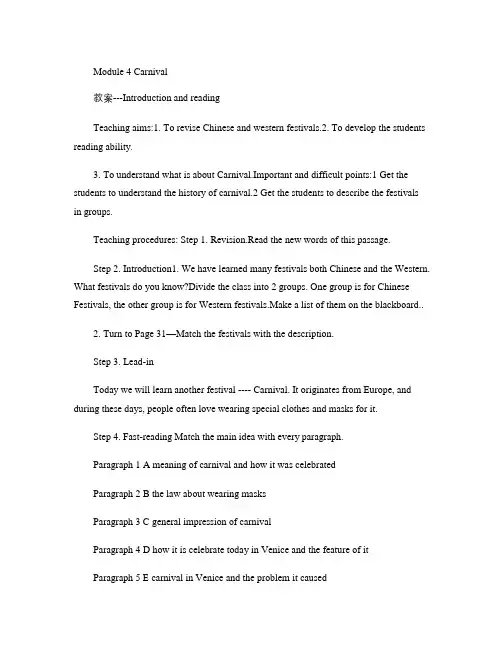
Module 4 Carnival教案---Introduction and readingTeaching aims:1. To revise Chinese and western festivals.2. To develop the students reading ability.3. To understand what is about Carnival.Important and difficult points:1 Get the students to understand the history of carnival.2 Get the students to describe the festivalsin groups.Teaching procedures: Step 1. Revision.Read the new words of this passage.Step 2. Introduction1. We have learned many festivals both Chinese and the Western. What festivals do you know?Divide the class into 2 groups. One group is for Chinese Festivals, the other group is for Western festivals.Make a list of them on the blackboard..2. Turn to Page 31—Match the festivals with the description.Step 3. Lead-inToday we will learn another festival ---- Carnival. It originates from Europe, and during these days, people often love wearing special clothes and masks for it.Step 4. Fast-reading Match the main idea with every paragraph.Paragraph 1 A meaning of carnival and how it was celebratedParagraph 2 B the law about wearing masksParagraph 3 C general impression of carnivalParagraph 4 D how it is celebrate today in Venice and the feature of itParagraph 5 E carnival in Venice and the problem it causedParagraph 6 F the revival of the tradition of celebrating it.(Answers: 1—6 CAEBFDStep 5. Further-readingRead the passage and answer the questions.1. Where does Carnival come from? What does it mean?2. When was it celebrated?3. Where was the most famous Carnival in Europe?6. Who started the Carnival again, tourists orstudents?4. How long did the first Carnival in Venice last? What about now?5. Did the government of Venice encourage the wearing of masks?(Answers: 1. “Carnival” comes from two Latin words, meaning “no more meat”. 2. It beganjust after Christmas. 3. The most famous carnival in Europe was in Venice. 4. At thebeginning, it lasted for just one day. 5. No. 6. The students started the Carnival.Step 6. V ocabularyActivity 1: Read through the words in the box and have the students repeat them individually.Ask the students to complete the task individually, then check with a partner. Check the answerstogether:(Answers: 1. confusion 2. excitement 3. mask 4. mystery 5. magic 6. costume 7. crowd8. tradition 9. atmosphere Activity 2: Choose the correct meanings of the words and phrases.Check the answers one by one.(Answers: 1—4 babb 5—8 abbbStep 7. Discussion Discuss in groups of four.1.What is the feature of carnival in Venice?2. Which is your favourite festival?Step 8. V ocabulary1. Read the words about food.2. Now say which things you eat at a festival.. Practice.Activity 2: Find these things in the box in Activity 1.(1 Two type of meat ( (3 five vegetables ((2 a food that consists of a tube of skin containing meat mixed with herbs. ((4 two ingredients for making a cake( (4 flour, eggs(Answers: (1 pork and chicken (2 sausages (3 beans, cabbages, garlic, onion, peasStep 9. Homework1. Workbook—on Page 871.Read the passage and match the headings with the text.2. Write a short passage about your favorite festival.。
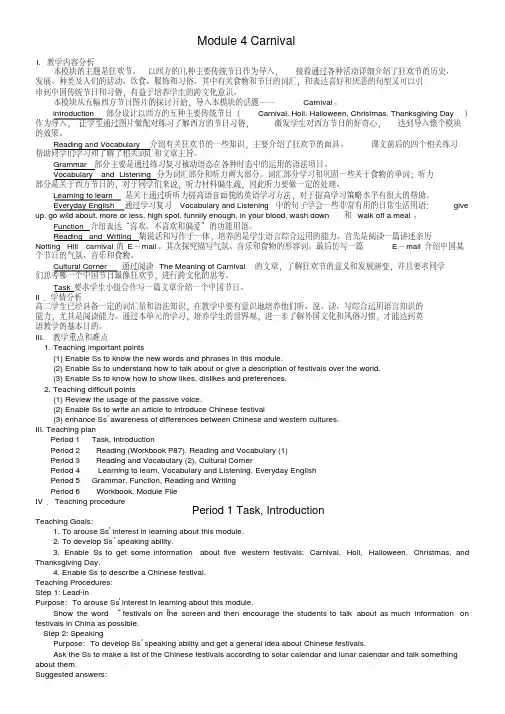
Module 4 CarnivalI. 教学内容分析本模块的主题是狂欢节。
以西方的几种主要传统节日作为导入,接着通过各种活动详细介绍了狂欢节的历史、发展、种类及人们的活动、饮食、服饰和习俗。
其中有关食物和节日的词汇,和表达喜好和厌恶的句型又可以引申到中国传统节日和习俗,有益于培养学生的跨文化意识。
本模块从五幅西方节日图片的探讨开始,导入本模块的话题——Carnival。
Introduction 部分设计以西方的五种主要传统节日(Carnival, Holi, Halloween, Christmas, Thanksgiving Day)作为导入,让学生通过图片做配对练习了解西方的节日习俗,激发学生对西方节日的好奇心,达到导入整个模块的效果。
Reading and Vocabulary介绍有关狂欢节的一些知识,主要介绍了狂欢节的面具。
课文前后的四个相关练习帮助同学们学习和了解了相关词汇和文章主旨。
Grammar部分主要是通过练习复习被动语态在各种时态中的运用的语法项目。
Vocabulary and Listening分为词汇部分和听力两大部分。
词汇部分学习和巩固一些关于食物的单词;听力部分是关于西方节日的,对于同学们来说,听力材料偏生疏,因此听力要做一定的处理。
Learning to learn是关于通过听听力提高语音面貌的英语学习方法,对于提高学习策略水平有很大的帮助。
Everyday English通过学习复习Vocabulary and Listening中的句子学会一些非常有用的日常生活用语:give up, go wild about, more or less, high spot, funnily enough, in your blood, wash down 和walk off a meal。
Function介绍表达“喜欢、不喜欢和偏爱”的功能用语。
Reading and Writing集说话和写作于一体,培养的是学生语言综合运用的能力。
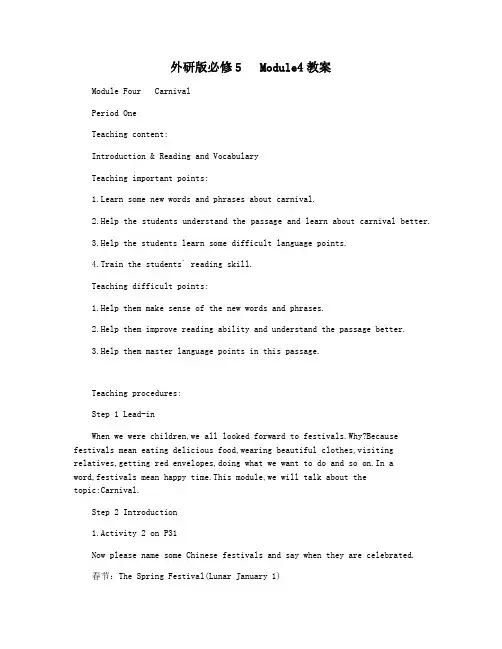
外研版必修5 Module4教案Module Four CarnivalPeriod OneTeaching content:Introduction & Reading and VocabularyTeaching important points:1.Learn some new words and phrases about carnival.2.Help the students understand the passage and learn about carnival better.3.Help the students learn some difficult language points.4.Train the students` reading skill.Teaching difficult points:1.Help them make sense of the new words and phrases.2.Help them improve reading ability and understand the passage better.3.Help them master language points in this passage.Teaching procedures:Step 1 Lead-inWhen we were children,we all looked forward to festivals.Why?Because festivals mean eating delicious food,wearing beautiful clothes,visiting relatives,getting red envelopes,doing what we want to do and so on.In aword,festivals mean happy time.This module,we will talk about thetopic:Carnival.Step 2 Introduction1.Activity 2 on P31Now please name some Chinese festivals and say when they are celebrated.春节:The Spring Festival(Lunar January 1)元宵节:The Lantern Festival(Lunar January 15)清明节:Ching Ming Festival/Tomb-sweeping Day(Solar April 4-6)端午节:Dragon Boat Festival(Lunar May 5)七夕节:Double Seventh Festival(Lunar July 7)中秋节:Mid-Autumn Festival(Lunar August 15)重阳节:Double Ninth Festival(Lunar September 9)除夕:New Year` Eve(Lunar December 31)【清明节】清明是我国的二十四节气之一。
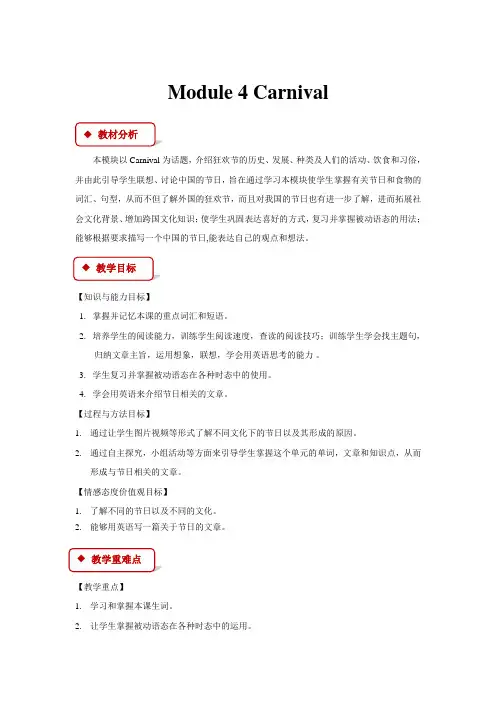
Module 4 Carnival本模块以Carnival 为话题,介绍狂欢节的历史、发展、种类及人们的活动、饮食和习俗,并由此引导学生联想、讨论中国的节日,旨在通过学习本模块使学生掌握有关节日和食物的词汇、句型,从而不但了解外国的狂欢节,而且对我国的节日也有进一步了解,进而拓展社会文化背景、增加跨国文化知识;使学生巩固表达喜好的方式,复习并掌握被动语态的用法;能够根据要求描写一个中国的节日,能表达自己的观点和想法。
1. 掌握并记忆本课的重点词汇和短语。
2. 培养学生的阅读能力,训练学生阅读速度,查读的阅读技巧;训练学生学会找主题句,归纳文章主旨,运用想象,联想,学会用英语思考的能力 。
3. 学生复习并掌握被动语态在各种时态中的使用。
4. 学会用英语来介绍节日相关的文章。
【过程与方法目标】1. 通过让学生图片视频等形式了解不同文化下的节日以及其形成的原因。
2. 通过自主探究,小组活动等方面来引导学生掌握这个单元的单词,文章和知识点,从而形成与节日相关的文章。
【情感态度价值观目标】1. 了解不同的节日以及不同的文化。
2. 能够用英语写一篇关于节日的文章。
【教学重点】1. 学习和掌握本课生词。
2. 让学生掌握被动语态在各种时态中的运用。
【教学难点】1.多层次的训练阅读能力,提高阅读水平2.怎样让学生灵活使用词汇、短语和句型形成有质量的文章。
PPT、录音机等Step 1 Introduction and reading1. Lead-inT: How many festivals you know?Ss: Thanksgiving Day/Christmas/ Spring Festival/ Mother’s Day...T: Do you know the following festival? Now please look at the photos below and answer the questions.What is the person wearing?Do you know what festival it is?Anything else do you know about this festival?Ss: She is wearing a mask, maybe to celebrate some important things.T: Great guessing. Carnival is celebrated on February 21-23 each year. Let’s enjoy some beautiful pictures of the carnival in Venice.2.while-readingT: please read the passage quickly and match the main idea for each paragraph.Ss: Para. 1 for D, Par. 2 for C….T: great. Read the passage again and answer the questionsWhere did carnival begin?What did people usually do in the most famous carnival in Venice?According to the laws, what were people not allowed to do?Who revived carnival?Why does nobody take the masks off?Ss: It began in Europe….。

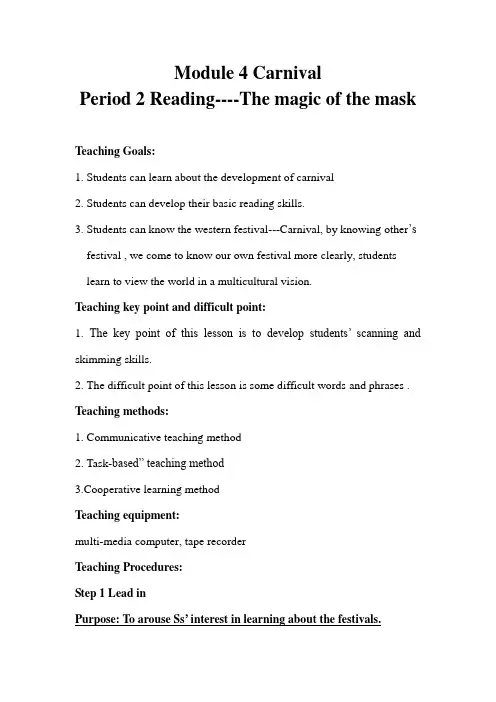
Module 4 CarnivalPeriod 2 Reading----The magic of the maskTeaching Goals:1. Students can learn about the development of carnival2. Students can develop their basic reading skills.3. Students can know the western festival---Carnival, by knowing other’s festival , we come to know our own festival more clearly, students learn to view the world in a multicultural vision.Teaching key point and difficult point:1. The key point of this lesson is to develop students’ scanning and skimming skills.2. The difficult point of this lesson is some difficult words and phrases . Teaching methods:1. Communicative teaching method2. Task-based” teaching method3.Cooperative learning methodTeaching equipment:multi-media computer, tape recorderTeaching Procedures:Step 1 Lead inPurpose: To arouse Ss’ interest in learning about the festivals.1. Ask Ss to name some chinese festivals.2. Small discussion:Which one is your favorite Chinese festival?3. Ask Ss to name the foreign festivals in the pictures.Step 2 ReadingPurpose: To develop some basic reading skills and get some information about carnival.Task1. Listen to the tape and choose the topics of the text.Task 2. Skim the text and match the topics with the paragraphs.Task 3. Scan the text and answer the detailed questions.Task 4. Read the text carefully and fill in the blank.Task 5. Test about the readingStep 3 Key pointsPurpose: This step is a practice section, aims to demonstrate their own ability of using language to do things.1.Think of carnival, and you think of crowds, costumes, and confusion.2.In Europe, where it began , carnival was followed by forty dayswithout meat,as people prepared for the Christian festival of Easter.3.Having fun meant eating ,drinking and dressing up.4.Ordinary people could pretend to be rich and important, while famouspeople could have romantic adventures in secret .Step 4 Retelling the textPurpose: Enable Ss to learn about the details of text and help them to talk about carnival. Let them to know what they have learnt during the class.Step 5 Homework1.Activity 3 on P32 and Activity 4 on P33.2.Finish V ocabulary exercises in WB .。
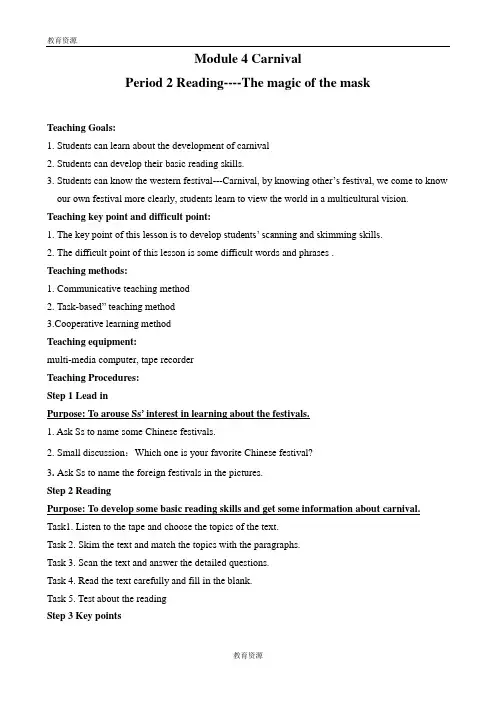
Module 4 CarnivalPeriod 2 Reading----The magic of the maskTeaching Goals:1. Students can learn about the development of carnival2. Students can develop their basic reading skills.3. Students can know the western festival---Carnival, by knowing other’s festival, we come to know our own festival more clearly, students learn to view the world in a multicultural vision. Teaching key point and difficult point:1. The key point of this lesson is to develop students’ scanning and skimming skills.2. The difficult point of this lesson is some difficult words and phrases .Teaching methods:1. Communicative teaching method2. Task-based” teaching method3.Cooperative learning methodTeaching equipment:multi-media computer, tape recorderTeaching Procedures:Step 1 Lead inPurpose: To arouse Ss’ interest in learning about the festivals.1. Ask Ss to name some Chinese festivals.2. Small discussion:Which one is your favorite Chinese festival?3. Ask Ss to name the foreign festivals in the pictures.Step 2 ReadingPurpose: To develop some basic reading skills and get some information about carnival.Task1. Listen to the tape and choose the topics of the text.Task 2. Skim the text and match the topics with the paragraphs.Task 3. Scan the text and answer the detailed questions.Task 4. Read the text carefully and fill in the blank.Task 5. Test about the readingStep 3 Key pointsPurpose: This step is a practice section, aims to demonstrate their own ability of using language to do things.1.Think of carnival, and you think of crowds, costumes, and confusion.2.In Europe, where it began , carnival was followed by forty days without meat, as peopleprepared for the Christian festival of Easter.3.Having fun meant eating ,drinking and dressing up.4.Ordinary people could pretend to be rich and important, while famous people could haveromantic adventures in secret .Step 4 Retelling the textPurpose: Enable Ss to learn about the details of text and help them to talk about carnival. Let them to know what they have learnt during the class.Step 5 Homework1.Activity 3 on P32 and Activity 4 on P33.2.Finish V ocabulary exercises in WB .。
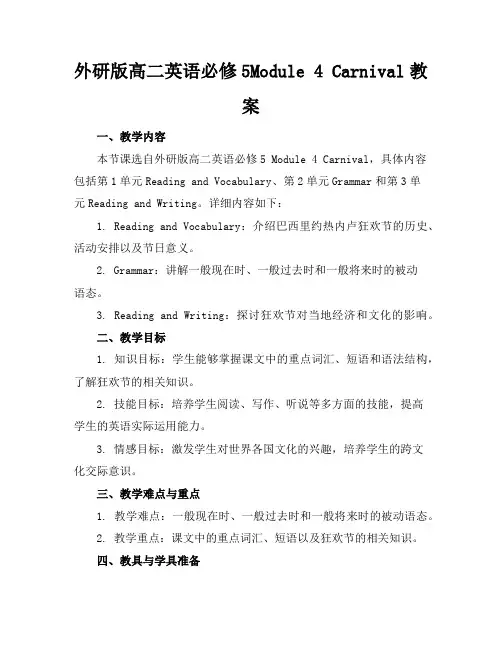
外研版高二英语必修5Module 4 Carnival教案一、教学内容本节课选自外研版高二英语必修5 Module 4 Carnival,具体内容包括第1单元Reading and Vocabulary、第2单元Grammar和第3单元Reading and Writing。
详细内容如下:1. Reading and Vocabulary:介绍巴西里约热内卢狂欢节的历史、活动安排以及节日意义。
2. Grammar:讲解一般现在时、一般过去时和一般将来时的被动语态。
3. Reading and Writing:探讨狂欢节对当地经济和文化的影响。
二、教学目标1. 知识目标:学生能够掌握课文中的重点词汇、短语和语法结构,了解狂欢节的相关知识。
2. 技能目标:培养学生阅读、写作、听说等多方面的技能,提高学生的英语实际运用能力。
3. 情感目标:激发学生对世界各国文化的兴趣,培养学生的跨文化交际意识。
三、教学难点与重点1. 教学难点:一般现在时、一般过去时和一般将来时的被动语态。
2. 教学重点:课文中的重点词汇、短语以及狂欢节的相关知识。
四、教具与学具准备1. 教具:多媒体课件、黑板、粉笔。
2. 学具:教材、笔记本、字典。
五、教学过程1. 导入:通过展示巴西里约热内卢狂欢节的图片和视频,引发学生对狂欢节的兴趣,为新课的学习做好铺垫。
2. 阅读理解:学生自主阅读课文,完成相关练习,了解狂欢节的历史、活动安排和意义。
3. 语法讲解:教师讲解一般现在时、一般过去时和一般将来时的被动语态,并举例说明。
4. 例题讲解:分析教材中的例题,引导学生运用所学的语法知识进行改写句子。
5. 随堂练习:学生完成课堂练习,巩固所学知识。
6. 小组讨论:学生分组讨论狂欢节对当地经济和文化的影响,并进行汇报。
六、板书设计1. 课文Carnival2. 重点词汇:history、schedule、economy、culture3. 语法结构:被动语态(一般现在时、一般过去时、一般将来时)七、作业设计1. 作业题目:(1)用被动语态改写下列句子。
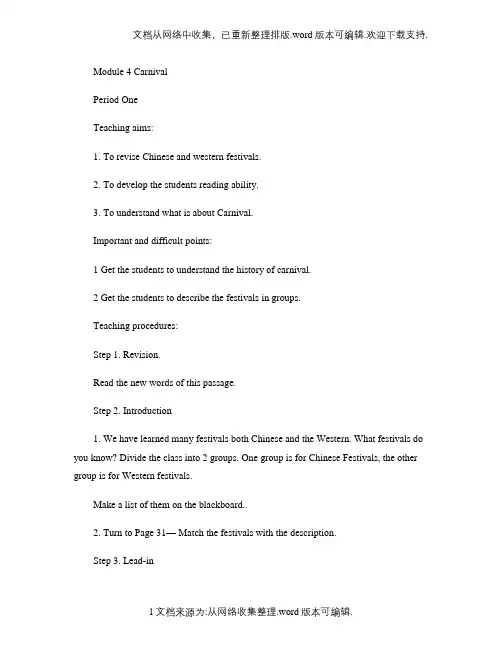
Module 4 CarnivalPeriod OneTeaching aims:1. To revise Chinese and western festivals.2. To develop the students reading ability.3. To understand what is about Carnival.Important and difficult points:1 Get the students to understand the history of carnival.2 Get the students to describe the festivals in groups.Teaching procedures:Step 1. Revision.Read the new words of this passage.Step 2. Introduction1. We have learned many festivals both Chinese and the Western. What festivals do you know? Divide the class into 2 groups. One group is for Chinese Festivals, the other group is for Western festivals.Make a list of them on the blackboard..2. Turn to Page 31— Match the festivals with the description.Step 3. Lead-inToday we will learn another festival ---- Carnival. It originates from Europe, and during thesedays, people often love wearing special clothes and masks for it.Step 4. Fast-readingMatch the main idea with every paragraph.Paragraph 1 A meaning of carnival and how it was celebratedParagraph 2 B the law about wearing masksParagraph 3 C general impression of carnivalParagraph 4 D how it is celebrate today in Venice and the feature of it Paragraph 5 E carnival in Venice and the problem it causedParagraph 6 F the revival of the tradition of celebrating it.(Answers: 1— 6 CAEBFDStep 5. Further-readingRead the passage and answer the questions.1. Where does Carnival come from? What does it mean?2. When was it celebrated?3. Where was the most famous Carnival in Europe?4. How long did the first Carnival in Venice last? What about now?5. Did the government of Venice encourage the wearing of masks?6. Who started the Carnival again, tourists or students?(Answers: 1. “Carnival” comes from two Latin words, meaning “no more meat”. 2. It began just after Christmas. 3. The most famous carnival in Europe was in Venice. 4. At the beginning, it lasted for just one day. 5. No. 6. The students started the Carnival. Step 6. VocabularyActivity 1: Read through the words in the box and have the students repeat them individually. Ask the students to complete the task individually, then check with a partner. Check the answers together:(Answers: 1. confusion 2. excitement 3. mask 4. mystery 5. magic 6. costume 7. crowd 8. tradition 9. atmosphereActivity 2: Choose the correct meanings of the words and phrases.Check the answers one by one.(Answers: 1— 4 babb 5— 8 abbbStep 7. DiscussionDiscuss in groups of four.1. What is the feature of carnival in Venice?2. Which is your favourite festival?Step 8. Homework1. Workbook— on Page 87.Read the passage and match the headings with the text.2. Write a short passage about your favorite festival.Period TwoTeaching aims:1. To listen to the description about western customs.2. To express likes, dislikes and preferences:(1 I love doing…;(2 I don’t like…; I hate…; I dislike…; I don’t care much for(3 I prefer…to…; I prefer doing …(4 I’d rather…than…(5 I an interested in…3. To learn several phrases.Difficult and important points:1. Get the students to express likes and dislikes2. Learn to use the phrases: give up; go wild ;more or less; high spot; funnily enough; in your blood; wash down; walk offTeaching procedures:Step 1. RevisionCheck the homework.— Ask several students to read the short passage with the name of My Favorite Festival.Step 2. Vocabulary1. Read the words about food.2. Now say which things you eat at a festival.3. Practice.Activity 2: Find these things in the box in Activity 1.(1 Two type of meat ((2 a food that consists of a tube of skin containing meat mixed with herbs. ((3 five vegetables ((4 two ingredients for making a cake ((Answers: (1 pork and chicken (2 sausages (3 beans, cabbages, garlic, onion, peas (4 flour, eggsStep 3. ListeningBefore listening— Look at the photos in Activity 4 and tell them every picture meaning a special festival..While listening— Listen to the tape twice and match the names of the festivals with the photos.After Listening:Complete the tableStep 4. Everyday English1. Read the sentences and choose the correct meaning of the words and phrases.2. Check the answers one by one. (1-b (2 a (3 b (4a (5 b (6 a (7a (8b3. Explain the words and phrases.(1give up sth. =don’t have it any more(2 go/wild with joy 欣喜若狂(3 more or less =approximately (oppositeexactly.Eg: That is approximately correct.(4 high spot= the best part(5 be/run in sb.`s blood = be /run in the blood. 生来就有的(因遗传或环境影响eg; Most of my family are teachers, it runs in the blood.(6 wash down a meal = have a drinkwalk off a meal = help the food go down by walking.Step 5. Function1. Match the sentences with the speakers. Say what they are speaking about.(1Caitlin: King Cake(2Maria: Feijoada(3 Stefan: saugages(4 Cameron: traditional Jamaican food – chicken with rice and peas.2. Number the phrases from the most negative to the most positive(1 Ask the students to do this individually.(2 Call the answers back from the whole class, one at a time, from 1--6(3 Write down them on the blackboard:3. Work in pairs. Discuss your preferences for food to eat at festival. Use the phrases in Activity2.(1 Read the example with the class.(2 Pair the students to discuss their preferences.(3 Circulate and monitor their production.Step 6. HomeworkFinish off the workbook.Period ThreeTeaching aims:1. To learn more about carnival.2. To teach them how to write an e-mail.3. To develop the students’ reading skills.Difficult and important points:1. Get the students to learn to write an e-mail.2. Get the students to understand some important sentences.Teaching procedures:Step 1. RevisionRead the words and have a dictation.Step 2. Lead-inWhat do you remember about carnival?Where did it start first?Step 3. Fast-reading:Read and underline the topic sentences ( use your own words about every paragraph. Paragraph1: We can understand what carnival is all about by reading the history of America and the meeting of two cultures.Paragraph2: The slave trade brought millions of black people to the new world. Paragraph3: The slaves were forced to watch their European masters to celebrate carnival and then they began to hold carnival with their own features.Paragraph4: Carnival became a celebration of freedom.Paragraph5: As time went on, carnival became a way of uniting different communities and now it has become a celebration of life itself.Step 4. Further reading1. What did marked the beginning of the slave trade?2. How were millions of people taken to work as slaves?3. How did the slaves begin to hold their own carnival in Trinidad?4. When was the slave trade abolished?5. How was carnival changed when the slave trade was abolished?6. When did carnival become a way to unite different communities?(Answers: 1 That the arrival of European in America, and the opening of huge farms and plantations to grow cotton, fruit and vegetables, meant there was an immediate need to people to work on them marked the beginning of the slave trades. 2 Millions of people were taken by force from their homes in America and transported to the New World to work as slaves? 3. They painted their faces white, imitating their masters and making fun of them. 4. The slave trade was abolished in 1838. 5. It became more colourful and more exciting than it had been before. 6. As people forgot their everyday problems and enjoyed themselves eating, drinking, and dancing.Step 5. Several phrases(1 by force (2 be forced to do (3make fun of sb. (4 bring good luck (5 take over (6 take part in (7 become a celebration of freedom (8 with the time passing Step 6. Discussion1. What is the meaning of carnival?2. Which Chinese festival is most like carnival?Step 7. Reading and writingActivity1. Read the email and number the things in the order you read them1. Read through the things with the whole class and make sure that they understand them all.2. Ask them to read the email and order the things individually, then check with a partner.3. Call back the answers from the whole class, in order.(Answers: 1. the atmosphere at the festival 2. the music 3. the food 4. what the writer’s doing5. what the writer’s going to doActivity2. Underline the adjectives used to describe.1. the atmosphere: noisy/ colourful2. the music: great/ exciting/ relaxing3. the food: good/ tastyActivity3 Write an email from a Chinese festival. Make sure of the details about:1. the atmosphere2. the music3. the foodStep 8. HomeworkWrite a description of the festival for visitors to China.( For example: Spring Festival Period FourTeaching aims:1. To learn new words and expressions and learn how to use them.2. To review of the passive voices.Difficult and important points:1. Get the students to know how to use passive voices:一般现在时和一般过去时的被动语态2. The usage of: hide, pretend, memory, wander, come to an end, dress up; consist of be good for ,date from.Teaching procedures:Step 1. RevisionRead the sentences and find out what grammar are they?1. Is the room cleaned every day?2. We were woken up by a loud noise during the night.3. Something must be done before it is too late.4. Have you heard the news? The President has been shot?5. The car was three years old but hadn’t been used very much.6. There’s somebody walking behind us. I think we are being followed.Step 2. Presentation—被动语态被动语态的基本形式是 : be +过去分词根据时态的不同 , be的形式有所变化 .(1 一般现在时的被动语态 : am/is /are+过去分词 (口语可用 get/become或 got /became(2 一般过去时的被动语态 :was /were+过去分词被动语态的基本用法 :不知道或没有必要提到动作的执行者是谁时用被动语态 . 强调或突出动作的承受者常用被动语态 .(有时可省略 .使用被动语态应注意的几个问题 .(1 主动变被动时双宾语的变化 . 看下列例句eg: 我朋友在我生日时送我一本有趣的书 .My friend gave me an interesting book on my birthday.— An interesting book was given to me (by my friend on my birthday.— I was given an interesting book (by my friend on my birthday.(2 主动变被动时 , 宾补成主补 (位置不变 ; 作宾补的省略 to 的不定时在被动语态中应加 to. eg: 老板让他整天工作 .The boss made him work all day long.— He was made to work all day long (by the boss.(3 短语动词变被动语态时 , 勿要掉”尾巴”.eg: 孩子们被他照顾的很好 .— The children were taken good care of ( by her.eg: 要注意一下你的发音和拼写 .— Your pronunciation and spelling should be paid attention to.(4 情态动词和 be going to, be to, be sure to ,used to, have to, had better等结构变被动语态 , 只需将它们后面的动词原形变为 be +过去分词。
外研版高二英语必修5Module 4 Carnival教案一、教学内容本节课选自外研版高二英语必修5 Module 4 Carnival,主要内容包括教材的Chapter 1和Chapter 2。
Chapter 1介绍了狂欢节的起源、历史以及世界各地的狂欢节活动;Chapter 2着重讲解了巴西里约热内卢狂欢节的特色和魅力。
二、教学目标1. 了解狂欢节的起源、历史以及世界各地的狂欢节活动。
2. 掌握与狂欢节相关的英语词汇和表达方式,如“mask”, “costume”, “parade”等。
3. 提高学生的听说读写能力,尤其是听力理解和口语表达能力。
三、教学难点与重点教学难点:狂欢节相关词汇和表达方式的掌握,以及对听力材料的理解。
教学重点:培养学生运用所学知识进行口语表达和写作的能力。
四、教具与学具准备教具:PPT、录音机、磁带、卡片学具:教材、笔记本、彩色笔五、教学过程1. 导入:展示世界各地狂欢节的图片,引导学生谈论对狂欢节的了解和印象,激发学生兴趣。
2. 新课内容展示:a. Chapter 1:介绍狂欢节的起源、历史以及世界各地的狂欢节活动。
b. Chapter 2:讲解巴西里约热内卢狂欢节的特色和魅力。
3. 实践情景引入:分组讨论,让学生设想自己正在参加狂欢节,讨论如何准备和参与狂欢节。
4. 例题讲解:分析教材中的例句,讲解狂欢节相关词汇和表达方式。
5. 随堂练习:让学生运用所学知识进行口语表达和写作练习。
六、板书设计1. 狂欢节相关词汇和表达方式2. 巴西里约热内卢狂欢节特色七、作业设计1. 作业题目:以小组为单位,编写一篇关于狂欢节的短文,内容包括狂欢节的起源、历史、世界各地狂欢节活动以及自己参加狂欢节的设想。
2. 答案:学生完成作业后,教师进行批改,给予评价和建议。
八、课后反思及拓展延伸1. 反思:针对本节课的教学效果,教师应思考如何更好地激发学生的学习兴趣,提高课堂参与度。
2. 拓展延伸:鼓励学生课后了解更多关于狂欢节的文化背景,如观看相关纪录片、阅读英文文章等,提高学生的跨文化交际能力。
必修5 Module 4 The magic of the mask- ReadingTeaching PlanTeaching aims1)To know more about the carnival2. Ability1)To improve reading ability,speaking and listening.2)To find the main idea of each paragraph and some details3. Mortal1) To strengthen the awareness of preserving Chinese traditional festivals.Teaching important and difficult points1. How to get the students to grasp the main idea and the key words of each section. Teaching methods:Task based teaching method, situational teaching method...Teaching assistant:PPTTeaching procedurePre-readingLead in1. Show some pictures to drive students’curiosity about the topic2.Lead students to describe the carnival by wet-chatting with Mr MaskWhile-reading1) Ask the students to read the passage quickly and match the main idea of paragraph (Individu al work)1. Match the main idea of each paragraph.A The origin of carnival and how it was celebrated in history.B The revival of the tradition of celebrating carnival.C The general impression of carnival.D Carnival in Venice.E The law about wearing masks.F The new carnival today in Venice and its feature.Para 1--- __C___ ②Para 2--- _A____③Para 3--- _D____ ④Para 4--- __E___⑤Para 5--- __B___ ⑥Para 6--- __F___1)Ask the students to read paragraph 1 for detailsPeople’s impression of carnival:Crowded Costumes Confusion2).Ask the students to read paragraph 3-6 and then finish the sentences about the development of Venice Carnival. (Pair work).Extension Activity(Group work)Do a game:Mask,Mask where to go?If you have a magical mask,Who do you want to pretend to be?What do you want to do?why? Moral lessonStrengthen the awareness of Chinese traditional festivals and get the belief that we will preserve our tradition and pass it down to next generation to makethe world better.Learning about the foreign culture makes us more conscious of our own.We should love our own culture.学习外国文化,能使我们对自己的文化有更清楚的认识。
Module 4 CarnivalI. 教学内容分析本模块的主题是狂欢节。
以西方的几种主要传统节日作为导入,接着通过各种活动详细介绍了狂欢节的历史、发展、种类及人们的活动、饮食、服饰和习俗。
其中有关食物和节日的词汇,和表达喜好和厌恶的句型又可以引申到中国传统节日和习俗,有益于培养学生的跨文化意识。
本模块从五幅西方节日图片的探讨开始,导入本模块的话题——Carnival。
Introduction 部分设计以西方的五种主要传统节日(Carnival, Holi, Halloween, Christmas, Thanksgiving Day)作为导入,让学生通过图片做配对练习了解西方的节日习俗,激发学生对西方节日的好奇心,达到导入整个模块的效果。
Reading and Vocabulary介绍有关狂欢节的一些知识,主要介绍了狂欢节的面具。
课文前后的四个相关练习帮助同学们学习和了解了相关词汇和文章主旨。
Grammar部分主要是通过练习复习被动语态在各种时态中的运用的语法项目。
Vocabulary and Listening分为词汇部分和听力两大部分。
词汇部分学习和巩固一些关于食物的单词;听力部分是关于西方节日的,对于同学们来说,听力材料偏生疏,因此听力要做一定的处理。
Learning to learn是关于通过听听力提高语音面貌的英语学习方法,对于提高学习策略水平有很大的帮助。
Everyday English通过学习复习Vocabulary and Listening中的句子学会一些非常有用的日常生活用语:give up, go wild about, more or less, high spot, funnily enough, in your blood, wash down 和walk off a meal。
Function介绍表达“喜欢、不喜欢和偏爱”的功能用语。
Reading and Writing集说话和写作于一体,培养的是学生语言综合运用的能力。
首先是阅读一篇讲述亲历Notting Hill carnival的E-mail。
其次探究描写气氛、音乐和食物的形容词。
最后仿写一篇E-mail介绍中国某个节日的气氛、音乐和食物。
Cultural Corner 通过阅读The Meaning of Carnival的文章,了解狂欢节的意义和发展演变,并且要求同学们思考哪一个中国节日最像狂欢节,进行跨文化的思考。
Task要求学生小组合作写一篇文章介绍一个中国节日。
II.学情分析高二学生已经具备一定的词汇量和语法知识,在教学中要有意识地培养他们听、说、读、写综合运用语言知识的能力,尤其是阅读能力。
通过本单元的学习,培养学生的世界观,进一步了解外国文化和风俗习惯,才能达到英语教学的基本目的。
III. 教学重点和难点1. Teaching important points(1) Enable Ss to know the new words and phrases in this module.(2) Enable Ss to understand how to talk about or give a description of festivals over the world.(3) Enable Ss to know how to show likes, dislikes and preferences.2. Teaching difficult points(1) Review the usage of the passive voice.(2) Enable Ss to write an article to introduce Chinese festival(3) enhance Ss’ awareness of differences between Chinese and western cultures.III. Teaching planPeriod 1 Task, IntroductionPeriod 2 Reading (Workbook P87), Reading and Vocabulary (1)Period 3 Reading and Vocabulary (2), Cultural CornerPeriod 4 Learning to learn, Vocabulary and Listening, Everyday EnglishPeriod 5 Grammar, Function, Reading and WritingPeriod 6 Workbook, Module FileIV.Teaching procedurePeriod 1 Task, IntroductionTeaching Goals:1. To arouse Ss’ interest in learning about this module.2. To develop Ss’ speaking ability.3. Enable Ss to get some information about five western festivals: Carnival, Holi, Halloween, Christmas, and Thanksgiving Day.4. Enable Ss to describe a Chinese festival.Teaching Procedures:Step 1: Lead-inPurpose: To arouse Ss’ interest in learning about this module.Show the word “festivals” on the screen and then encourage the students to talk about as much information on festivals in China as possible.Step 2: SpeakingPurpose: To develop Ss’ speaking ability and get a general idea about Chinese festivals.Ask the Ss to make a list of the Chinese festivals according to solar calendar and lunar calendar and talk something about them.Suggested answers:Step 3: IntroductionPurpose: Enable Ss to get some information about five western festivals: Carnival, Holi, Halloween, Christmas, and Thanksgiving Day.Ask Ss to talk something about Western festivals and finish Introduction in our textbook on P31.Suggested answers of Activity 1: 1. Christmas 2. Holi 3. Carnival4. Thanksgiving Day5. HalloweenThe answers of Activity 3&4 are open. They depend on the students. Step 4: Pair workPurpose: To teach Ss how to describe a festival.Christmas---This is a Christian festival which come in the middle of winter.IntroductionChristmastreeChristmas old manChristmas cardAsk the Ss to describe Christmas , and pay attention to the following points.Since about 400 AD, Christians have celebrated the birth of Jesus.圣诞节(Christmas)是基督教的一个重要的节日,定于每年12月25日,纪念耶稣基督的诞生,同时也是普遍庆祝的世俗节日。
costumes Step 5: Free talkPurpose: Enable the students to describe a Chinese festival.Ask the Ss to follow the listening material and talk something about a Chinese festival with their partner or give us an introduction/description of a Chinese festival. Step6: HomeworkWrite a description about a Chinese festival.Period 2 Reading (Workbook P87) , Reading and Vocabulary (1)Teaching Goals:1. To get some information about Christmas traditions.2. To develop some basic reading skills —Skimming, and Scanning.3. To deal with the new words and phrases.4. Help Ss to talk about the development of carnivals.Teaching Procedures:Step 1 Lead inPurpose: To arouse Ss’ interest in learning about the festivals.Ask Ss to share the information that they have known about the festivals over the world in groups.Festivals over the world世界消费者权益日(3月15日)-----World Consumer Right Day世界水日(3月22日)-----World Water Day世界卫生日(4月7日)-----World Health Day世界地球日(4月22日)-----World Earth Day世界无烟日(5月31日)-----World No-smoking Day世界环境日(6月5日)-----World Environment Day世界人口日(7月11日)-----World Population Day世界旅游日(9月27日)-----World Tourism Day世界爱滋病日(12月1日)-----World Aids Day世界残疾日(12月3日)-----World Disabled DayStep 2 Reading (Workbook P87)Purpose: To develop some basic reading skills and get some information about Christmas traditions.1. Ask the Ss to read the headings and match the headings with the paragraphs.Suggested answers: A5 B1 C2 D6 E3 F42. Ask the Ss to read the passage again and choose the correct answer on P88.Suggested answers: (1) c(2)a (3)b (4)a (5)c3. Ask the Ss to skim the passage and answer the questions of Activity 9.Suggested answers:(1) The 25th December was the old mid-winter festival in pre-Christian times.(2) The tradition of the Christmas tree started to give people hope that spring will come again.(3) As a way of keeping in touch with family and friends.(4) Children enjoy Christmas because they received lots of presents.(5) Some people love Christmas and others hate it.(6) Yes, because it is about the birth of Christianity. / No, because people who are not Christians celebrate it as well.Step 3 Pre-readingPurpose: Enable Ss to talk about the origins of carnivals and two different kinds of carnivals and help them to talk about the development of carnivals.1. Ask Ss to look at the pictures of carnivals and discuss the following questions.Q1. What’s the feature of carnivals?Q2. What is the food?Q3. What do you think of their costumes?Suggested answers:A1. The feature of the carnivals is the mystery of the mask.A2. In some places, the food is just like Thanksgiving Day. There are turkey, turkey dressing and some pumpkin pies.A3. The costumes that they wear are very strange and exaggerated.Step 4 While-readingPurpose: To get more information about carnivals.1. Scanning: Ask Ss to scan the passage and finish activity 1.Suggested answers:The first and the fourth topics are mentioned in the passage.2. Skimming Ask Ss to skim the passage and finish activity 2.Suggested answers:(1)c (2)b (3)c 4(a) (5)b (6)b (7)b (8)b3. Pair work: New words studyingPurpose: To deal with the new words and phrases in the passage.1. Ask Ss to read the passage again and finish Activity 3 and 4.Suggested answers of activity 3:(1) confusion (2) excitement (3) mask(4) mystery (5) magic (6) costume(7) crowd (8) tradition (9) atmosphereSuggested answers of activity 4:(1) b (2)a (3) b (4)b (5)a (6) b (7)b (8)b2. Ask Ss to use dictionary and wordlist to deal with the new words and phrases.Step 5 Post-reading (group work)Purpose: Enable Ss to talk about the origins of carnivals and two different kinds of carnivals.Ask Ss to read the passage again and then work in groups to talk about the origins of carnivals and two different kinds of carnivals.Step 6 HomeworkTry to find the difficult sentences for you in the passage.Period 3 Reading and Vocabulary (2), Cultural CornerTeaching Goals:1. To develop a basic reading skill—analyzing the text.2. To deal with the language points in the text.3. To know the different festivals, culture and custom in different countries and getting more information about our country and world.Teaching Procedures:Step 1 Lead inPurpose: To review what we learnt in the last period and to develop a basic reading skill—analyzing the text.Ask Ss to work in pairs, try to analyze the text and get the main idea of each paragraph. Several minutes later, ask some students to show their opinions.Suggested answers:Paragraph 1: People’s general impression of carnival.Paragraph 2: The meaning of carnival and how it was celebrated in history.Paragraph 3: Carnival in Venice and the problem it caused when people celebrated it.Paragraph 4: The law about wearing masks.Paragraph 5: The revival of the tradition of celebrating carnival.Paragraph 6: How carnival is celebrated in Venice today and the feature of the carnival in Venice.Step 2 Language pointsPurpose: To train Ss’ listening ability and to deal with the language points in the text.Listen to the tape and deal with the language points in groups.Listen to the tape and follow it in a low voice. Then Ss are divided into six groups. Each group is supposed to read through each heading, and then discuss them.Paragraph 1.think of考虑, 关心, 想起, 想象, 有……的看法, 记起相关词组:(1) think for认为, 预料(2) think about 考虑, 回想Paragraph 2.at the end of 在...结尾,在....末端Eg at the end of the day 1.在一天的末了;相关词组:(1) at the start开始, 起初(2) at the beginning of在…初2. dress up v. 盛装, 打扮, 装饰, 伪装dress 用法:1)不可数名词n.[U] 服装The group of dancers wore national dress.可数名词n.[C] 女装;童装I haven't got a dress for the ball.2)不及物动词vi. 穿衣He washed, dressed and went out.She always dresses in green.3)及物动词vt. 给…穿衣His mother dressed him in new clothes.She hurriedly dressed the child and took him downstairs.She is dressed in red.及物动词vt. 装饰,打扮The ship was dressed with flags.及物动词vt. 敷药包扎The doctor cleaned and dressed the wound.及物动词vt. 整理;安排She often spends hours dressing her hair.她经常花很多时间梳头。